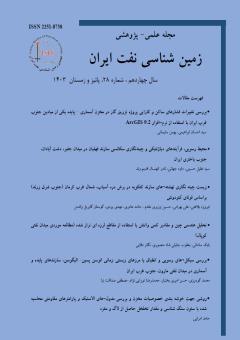روشی جهت خوشه بندی خصوصیات مخزن و بررسی مدول های الاستیک و پارامترهای مقاومتی محاسبه شده با ستون سنگ شناسی و مقدار تخلخل حاصل از لاگ و مغزه
محورهای موضوعی : زمین شناسی نفت
1 - دانشگاه صنعتی سهند تبریز، دانشکده مهندسی نفت، فارغ از تحصیل کارشناسی ارشد مهندسی نفت
کلید واژه: گروه بندی مخزن, خوشه بندی چند تفکیکی بر پایه گراف, پارامترهای الاستیسیته و مقاومتی,
چکیده مقاله :
تعیین گونههای سنگی و محاسبه پارامترهای الاستیسیته و مقاومتی سازند از اصلیترین و پیچیدهترین پارامترهای پتروفیزیکی- ژئومکانیکی مخازن هیدروکربوری بوده که محاسبه دقیق آنها مبنای بسیاری از مطالعات مهندسی نفت و ژئومکانیک مخزن است. به این منظور در پژوهش حاضر در مرحله اول تعداد بهينه الكتروفاسيسها با روش خوشهسازي چند تفکیکی بر پايه گراف(MRGC[1])، براي چاه مورد مطالعه از ترکیب اطلاعات زمینشناسی، نمودارهای معمول و مصنوعی(NDS[2] و [3]VDL) بدست آمد. الگوریتم معرفی شده شامل اعمال اثر لیتولوژی(سنگشناسی) و نوع تخلخل در محاسبات جهت گروه بندی دقیق مخزن است. در این مرحله تعداد 5 کلاس و گروه بهينه الكتروفاسيسها با روش خوشهسازي چند تفکیکی بر پايه گراف(MRGC)، براي چاه مورد مطالعه بدست آمد. در مرحله دوم با توجه به اینکه محاسبه و تخمین ضرایب الاستیک و مقاومت سنگی از الزامات مطالعات ژئومکانیکی است و از طرفی داده مغزه در تمام طول چاه در دسترس نیست، به محاسبه مدول یانگ، نسبت پوآسون، مدول بالک، مدول برشی، میزان مقاومت فشاری تک محوری و مقاومت کششی تک محوری از نمودار صوتی دو قطبی برشی (DSI[4]) پرداخته شد. مقایسه مقادیر محاسبه شده مدولهای الاستیک و پارامترهای مقاومتی با تغییرات ستون سنگ شناسی و میزان تخلخل حاصل از ارزیابی پتروفیزیکی و مغزه گواه این است که با افزایش تخلخل مغزه و لاگ میزان مدولهای الاستیک و پارامترهای مقاومتی کاهش یافته پس بنابراین تخلخل با مدولهای الاستیک و پارامترهای مقاومتی رابطه عکس دارد. در این پژوهش، ضریب همبستگی مدول بالک محاسبه شده با تخلخل (R2=0.82)، مدول برشی (R2=0.73)، مدول یانگ (R2=0.77)، ضریب پواسون (R2=0.049)، مقاومت فشاری تک محوره (R2=0.84) و مقاومت کششی تک محوره (R2=0.65) بدست آمد.
[1] Multi- resplution graph- based clustering
[2] Neutron- Density Separation
[3] Velocity Deviation Log
[4] Dipole Shear Sonic Imager
Determining rock types and calculating the elastic and strength parameters of formations are among the most fundamental and complex petrophysical–geomechanical parameters in hydrocarbon reservoirs. Their accurate calculation forms the basis for many petroleum engineering and reservoir geomechanics studies. To this end, in the first stage of the present research, the optimal number of electrofacies was obtained for the studied well using a multi-partition clustering method based on the MRGC[1] graph, derived from a combination of geological data and both conventional and synthetic logs, including VDL[2] and NDS[3]. The proposed algorithm incorporates lithology effects and porosity types into calculations for accurate reservoir grouping. At this stage, five optimal electrofacies classes and groups were identified for the studied well using the MRGC-based clustering method. In the second stage, considering that calculating and estimating elastic and rock strength coefficients is essential in geomechanical studies – and since core data is not available throughout the entire well – calculations were made for Young’s modulus, Poisson’s ratio, bulk modulus, shear modulus, and uniaxial compressive strength using dipole sonic imaging (DSI) logs. The comparison of calculated elastic moduli and strength parameters with variations in the lithology column and porosity from petrophysical evaluation and core data confirms that as core and log porosity increase, the values of elastic moduli and strength parameters decrease. Hence, porosity has an inverse relationship with elastic moduli and strength parameters. In the present study, the correlation coefficient between the calculated bulk modulus and porosity was found to be (R2 = 0.82), shear modulus (R2 = 0.73), Young’s modulus (R2 = 0.77), Poisson’s ratio (R2 = 0.049), uniaxial compressive strength (R2 = 0.84), and uniaxial tensile strength (R2 = 0.65).
[1] Multi-resolution graph-based clustering
[2] Velocity Deviation Log
[3] Neutron- Density Separation

